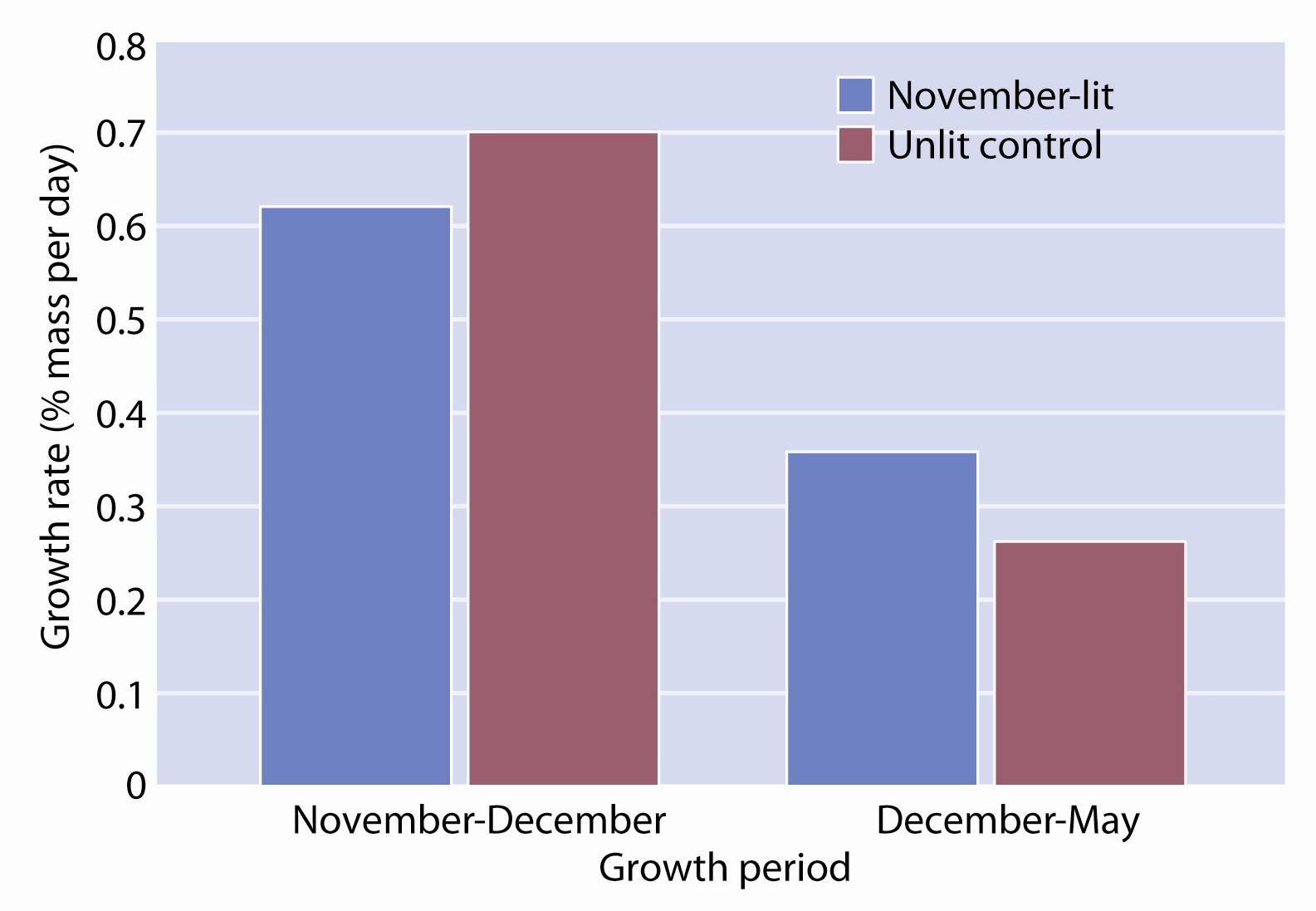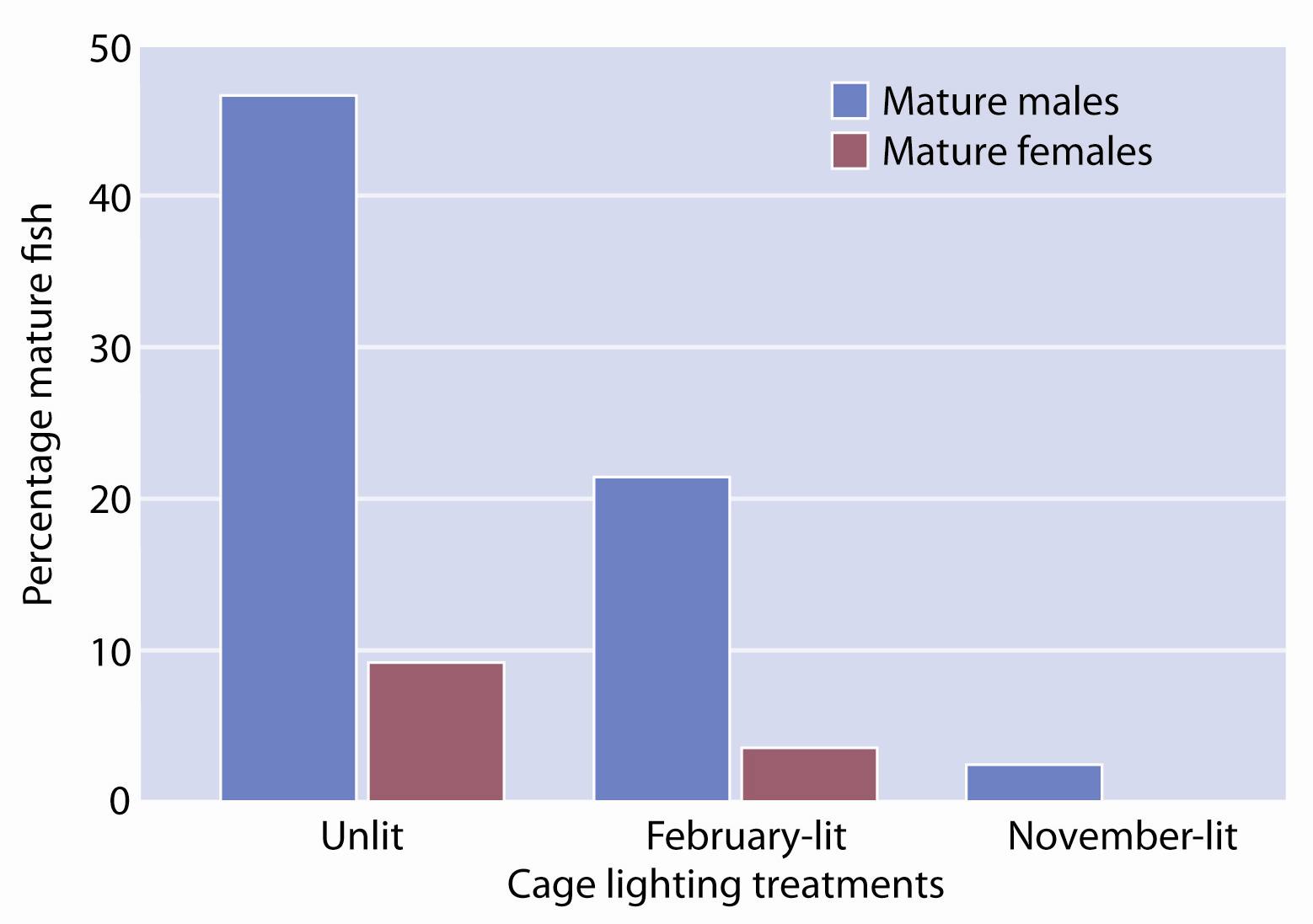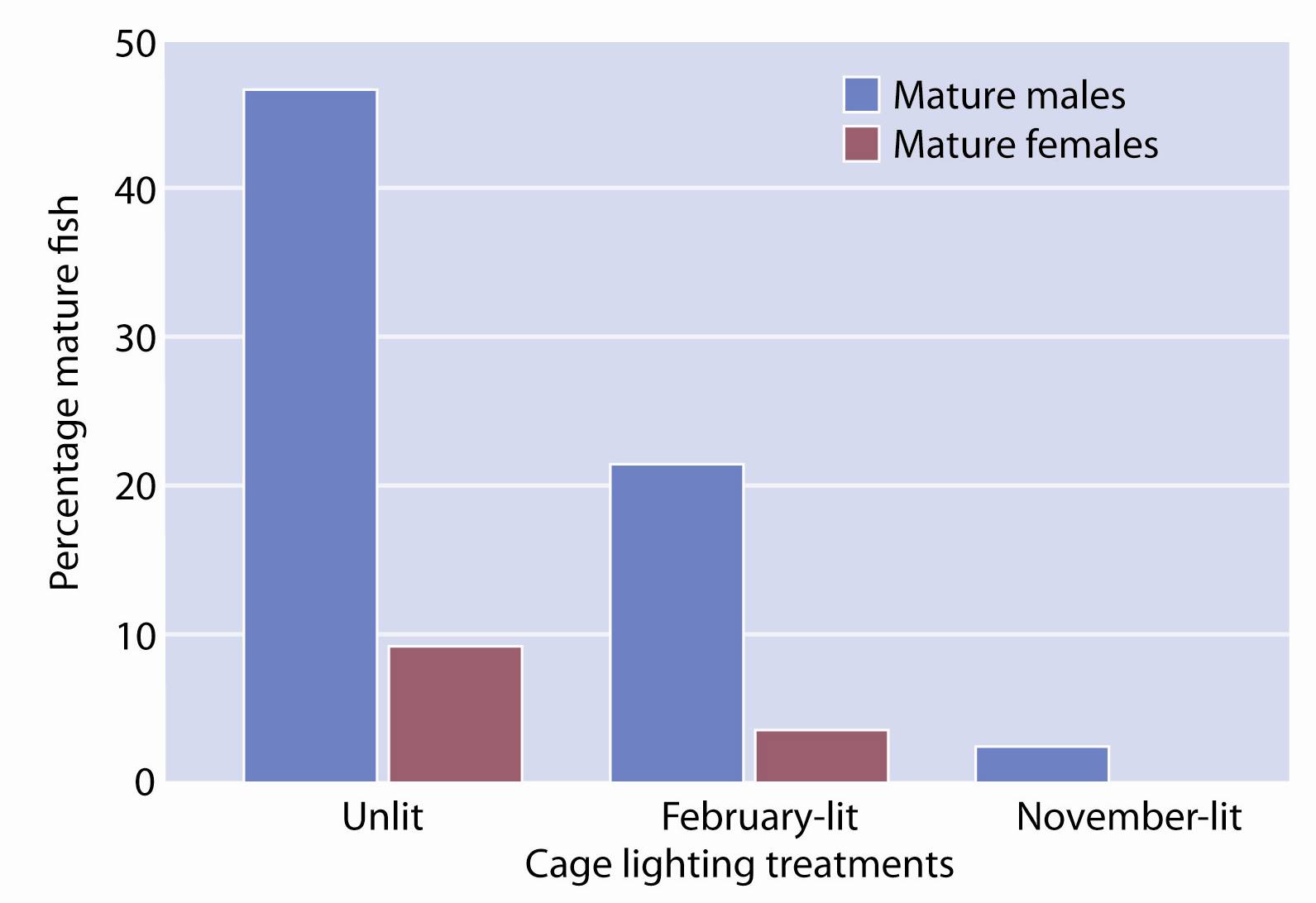Aquaculture Collaborative Research and Development Program (ACRDP) Fact Sheet
Issue 14 - May, 2012
Summary
One of the main challenges to the long term sustainability of the Atlantic Salmon industry in Canada is the early sexual maturation of fish following their first winter in sea cages. Early maturation reduces growth rates of fish, affecting the size and quality of the final product, and as a result farmers incur significant financial loss (4-9% gross income). This research investigates the potential of artificially increasing day length (photoperiod) during the grow-out period of fish as a way to overcome early sexual maturity.
In this study, two groups of immature farmed Atlantic Salmon were subjected to either 24-hour light from October/November to May or natural light conditions (control group). Results showed that fish in 24-hour light conditions had almost a total suppression of early sexual maturation in both males and females and an increased growth rate compared to the fish in natural light conditions. Follow up experiments by the project researcher have confirmed these results, but also showed that manipulating day length can begin later, in December, with similar effective results. The lower operating costs for a shorter photomanipulation season combined with improved quality of the final product will help increase the profitability of the industry. This research provides a cost-effective tool that will directly improve the productivity and sustainability of the Canadian Atlantic Salmon aquaculture industry.
Introduction
Early sexual maturation in farmed Atlantic Salmon results in reduced growth rates and reductions in farm productivity and profitability. Flesh from early maturing fish is of a significantly poorer quality ("downgraded"), which results in considerable losses in market value and farm revenue (Figure 1). Environmental conditions, such as water temperature and day length, are known to influence maturation in salmonids. This study examined the effect of extended light conditions (increased photoperiod) on the incidence of early maturation in farmed salmon.
Early maturation of salmon (known as grilsing) affects more than 30% of the fish in some sea cages in southwestern New Brunswick. In addition to the "downgrading" of fish flesh caused by grilsing, the stress of maturing in seawater after that first winter can also lead to increased disease susceptibility and financial losses. The stress on the fish in the farm is further compounded by the additional handling required to remove the grilse (matured salmon) from the cages.

Figure 1
Comparison image of identically-aged salmon: smaller grilse A (with long lower jaw or kype) and larger immature salmon B (lack of a kype).Previous studies have shown that Atlantic Salmon respond well to photomanipulation. Growth can be increased significantly by exposing parr (young salmon between 1-2 years old) to extended daylight, during autumn and early winter. Similarly, laboratory research has demonstrated that extended daylight can also increase post-smolt growth. To further evaluate the influence of light on salmon growth, this study examined the use of artificial lighting on sea cages in Southwestern New Brunswick.

Figure 2
Time line indicating number of months which study cages were exposed to 24 hour light.Methods
Two farm sites in Southwestern New Brunswick were evaluated. Site #1 contained twelve 70 m circular cages. Two artificial lights, simulating the natural light spectrum, were placed in each of six cages at depths of 5 m and 7 m, respectively. Three cages were lit on November 21, 2001, another three cages on February 15, 2002. Lights remained on 24 hours a day until May 31, 2002. The remaining six cages were maintained under natural light conditions.
Site #2 consisted of four 50 m circular cages. Two of these cages were exposed to artificial light 24 hours a day from October 31, 2001 to May 31, 2002, while the two control cages received only natural light.
Samples of fish were filmed within each of the cages using a synchronized dual video camera that, when lowered into the cage, videotaped the fish at 1, 2, 3, 4 and 5 m below the water surface. Fish mass was estimated from still images taken from the video. Images of salmon were calculated for length, girth and mass using a mathematical formula. Twenty fish were measured from each depth, with a total of 100 fish sampled per cage. Video-based measurements were made on three occasions: November 15, 2001, December 21, 2001, and May 29, 2002. February-lit cages were sampled at harvest rather than by video imaging.
On July 12, 2002, 59-74 fish were sampled from each cage at Site #1. Sex, round weight, fork length, girth, dressed weight, mean fat content, and gonad weight were recorded. Samples were also retrieved between August 12, 2002 and February 6, 2003 and length, weight, sex, maturity, and total muscle fat content (leanness) were recorded. The number of fish per cage sampled ranged between 91-153 fish.
On Site #2, 98-100 fish per cage were sampled from the lit cages on August 19, 2002 and from the control cages on September 4, 2002. Weight, sex, maturity, and total muscle fat content were recorded.
Data were analyzed to compare the growth characteristics and sexual maturation in salmon between lit and unlit treatments and among light period treatments.
Results
Growth and maturation
The growth of Atlantic Salmon in the lit cages was consistently greater than in the control cages. Initially, fish in the artificially-lit cages showed reduced growth compared to control cages, however, this was temporary. By May 2002, the fish from the cages lit in November (Site #1) had higher growth rates from December to May, at a rate of 0.32% body mass per day, compared to the control cages at 0.29% per day (Figure 3).

Figure 3
Comparison of growth rates between salmon sampled (video measurements) from unlit and November-lit cages on Site #1.In July, maturing fish in control cages were growing at a faster rate than immature fish (as determined from harvest weight samples). However, in the months preceding harvest (harvest from August 2002 through to February 2003) this was reversed, with mature fish growing very slowly.
Of the sampled fish in the control cages, 47% of the males and 9% of the females reached sexual maturity. Overall 22% of fish in control cages were mature. In the February-lit cages, 22% of the males and 3% of the females had sexually matured by the end of the study (Figure 3). The average percentage of mature fish in the February-lit cages was 11% but the results were variable among cages (2-19% incidence of maturation). In contrast, cages that were lit from November showed consistently that only 2% of the males sexually matured and none of the females matured by May 2003 (Figure 4). Overall only 1% percent of November-lit fish were mature.

Figure 4
Percentage of mature males and females in harvest samples from unlit, November- and February-lit cages on Site #1.Harvest data collected during August and September from Site #2 showed similar trends of reduced maturation rates with the application of light starting a month earlier, in October (Figure 5). In control cages 22.5% of the males and 3% of the females were mature; with an overall percentage mature of 17.5%. In these October-lit cages only 8.5% of the males and 1% of the females were mature.
No detectable difference was found in total lipid (fat) levels of sampled fish in the controls, the November-lit cages, or for the February-lit cages during the preliminary harvest.

Figure 5
Percentage of mature males and females in harvest samples from unlit, and lit cages on Site #2.Conclusions


A simple cost analysis of the use of light treatment equipment was conducted to obtain an estimate of the financial gains to farmers, should they employ this treatment method on their farms. The cost of purchasing, wiring and operating the lights was less than $5,000 per cage (2002 dollars). Based on November results for each 70 m sea cage, the potential net financial gain from maintaining high production rates and flesh quality, the result of delaying sexual maturity, would be greater than $100,000 per farm.
Follow-up experiments conducted in 2007 have confirmed that 24-hour light has a significant effect in reducing grilsing (early maturation) in cages. These experiments have also shown that light treatment beginning in December is as effective as in early autumn. This reduction in required light treatment duration represents a reduction in the cost of artificially lighting the cages and represents an additional cost savings to salmon farmers.
This ACRDP funded research contributes to sustainable aquaculture development in Canada by increasing production-related performance and increasing the competitiveness of the Canadian aquaculture industry.
This ACRDP project (MG-01-06-008) was a collaborative effort between the Department of Fisheries and Oceans (DFO Science) and Jail Island Aquaculture Ltd. The Project Manager Dr. Brian Glebe, can be contacted at Brian.Glebe@dfo-mpo.gc.ca.
For further information on this and other ACRDP projects, visit: /aquaculture/acrdp-pcrda/index-eng.htm.
Published by:
Aquaculture Science Branch
Fisheries and Oceans Canada
Ottawa, Ontario K1A 0E6
©Her Majesty the Queen in Right of Canada 2012
ISSN 1919-6806 (Print)
ISSN 1919-6814 (Online)
ISBN: 978-1-100-20664-6
DFO/2012-1828
Cat No.: Fs23-580/6-2012E-PDF
French version and alternative formats available through: /aquaculture/acrdp-pcrda/index-fra.htm.
- Date modified: